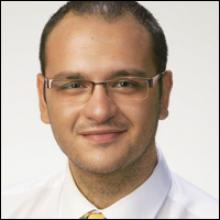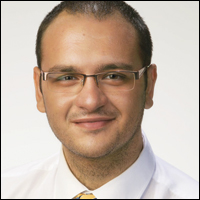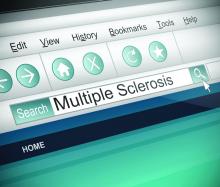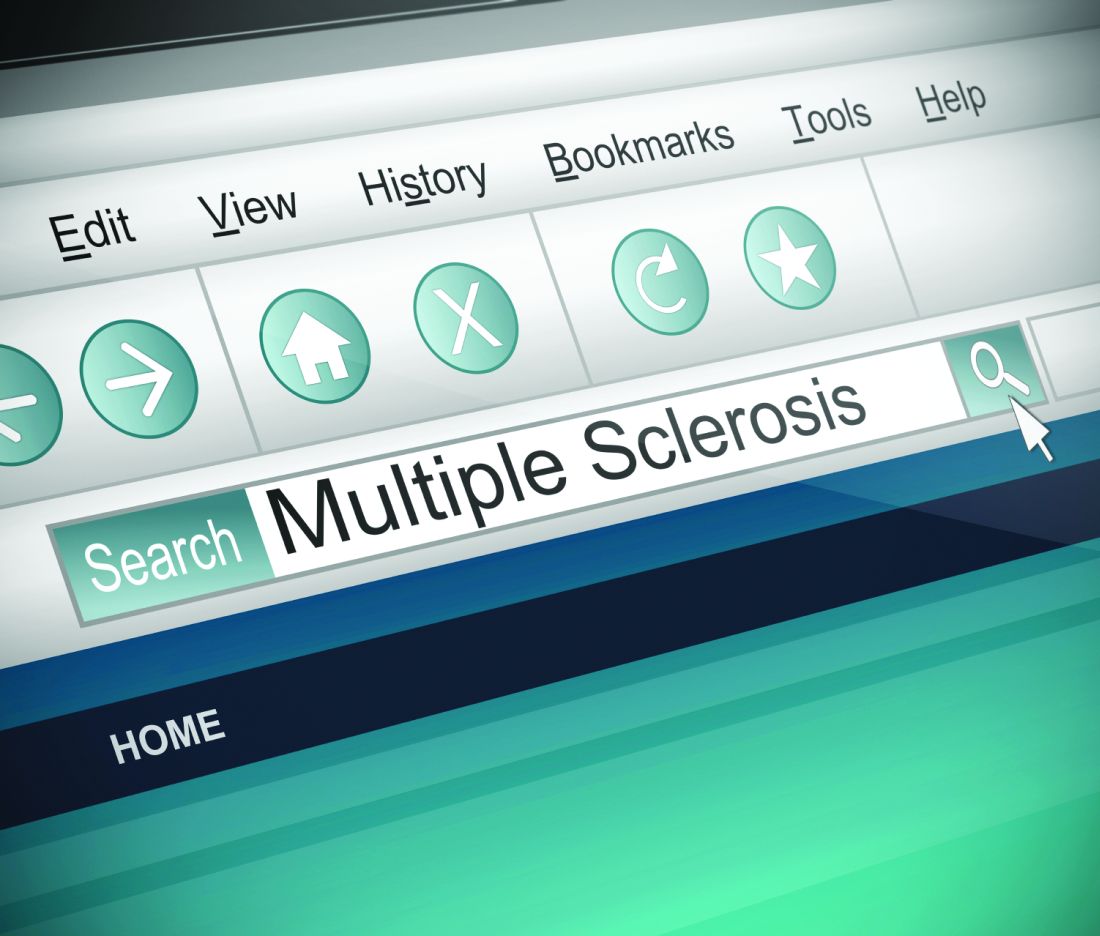User login
Multiple Sclerosis Hub
iPad app puts cognitive screening in the hands of MS patients
NASHVILLE, TENN. – A new computer tablet application puts cognitive screening literally in the hands of patients with multiple sclerosis.
The Multiple Sclerosis Performance Test (MSPT), created specifically for iPad, presents patients with four assessments that they can complete in a short time before any clinic visit, according to Stephen M. Rao, PhD, who helped develop the tool. After patients complete the test battery, the program translates their results into adjusted normative data and feeds them directly into the individual electronic medical record. When the clinic visit begins, everything is ready for the physician and patient to review together. The program not only provides a solid baseline assessment, but can also, over time, create a longitudinal profile of a patient’s cognitive status, and help to guide management decisions, Dr. Rao said at the annual meeting of the Consortium of Multiple Sclerosis Centers.
“About half of people with MS do have cognitive problems, which, above and beyond the physical problems, can result in major challenges with work, the ability to engage in social activities, and the need for personal assistance,” said Dr. Rao, who is the Ralph and Luci Schey Chair and director of the Schey Center for Cognitive Neuroimaging at the Cleveland Clinic. “But despite that, even comprehensive MS care centers rarely screen for cognitive dysfunction using objective neuropsychological tests.”
Time is the issue for most clinics, he said. Although the paper-and-pencil screening tools out there take only 10 minutes or so, most centers don’t have the luxury of carving out those extra moments or dedicating a staff member to administer the test and handle the data.
The MSPT attempts to sidestep the problem of time and manpower. In Dr. Rao’s center and the other 10 in the United States and Europe that now use the tool, patients simply arrive a bit early for their appointment and complete the three components: a structured patient history; the Neurological Quality of Life assessment; and an electronic adaptation of the MS Functional Composite.
It assesses cognition with a processing speed test based on the Symbol Digit Modalities Test, which has long been validated for MS patients. A contrast sensitivity test assesses visual acuity. A simple manual-dexterity test, in which patients move peg symbols into “holes,” tests upper extremity function, and a video-recorded walking speed test assesses lower extremity function.
The system was validated in 165 patients with MS and 217 healthy controls. It correlated well with the paper-and-pencil Symbol Digits Modalities Test, and correlated more highly than that test with cerebral T2 lesion load (MS Journal. 2017;23:1929-37).
The MSPT is part of a Biogen-sponsored project that Dr. Rao and colleagues unveiled at the American Academy of Neurology annual meeting in April, called the Multiple Sclerosis Partners Advancing Technology and Health Solutions (MS PATHS). It will gather longitudinal data on 11,000 patients using the MSPT program, and correlate it to multiple clinical and socioeconomic outcomes, Dr. Rao said.
The processing speed test portion of MS PATHS isn’t only available to PATHS centers, he added. Any clinician can obtain it by simply registering with Biogen and downloading the standalone version, which is called CogEval.
After downloading, the clinician must register with Biogen, which then will email a code to unlock the program. CogEval can be used on any iPad system that runs iOS 11 or higher. Results don’t get uploaded automatically into an EHR, but they can be entered manually or printed.
Dr. Rao disclosed that he received financial support from Biogen for the research and development of the MSPT program.
SOURCE: Rao SM et al. CMSC 2018. doi: 10.1177/1352458516688955
NASHVILLE, TENN. – A new computer tablet application puts cognitive screening literally in the hands of patients with multiple sclerosis.
The Multiple Sclerosis Performance Test (MSPT), created specifically for iPad, presents patients with four assessments that they can complete in a short time before any clinic visit, according to Stephen M. Rao, PhD, who helped develop the tool. After patients complete the test battery, the program translates their results into adjusted normative data and feeds them directly into the individual electronic medical record. When the clinic visit begins, everything is ready for the physician and patient to review together. The program not only provides a solid baseline assessment, but can also, over time, create a longitudinal profile of a patient’s cognitive status, and help to guide management decisions, Dr. Rao said at the annual meeting of the Consortium of Multiple Sclerosis Centers.
“About half of people with MS do have cognitive problems, which, above and beyond the physical problems, can result in major challenges with work, the ability to engage in social activities, and the need for personal assistance,” said Dr. Rao, who is the Ralph and Luci Schey Chair and director of the Schey Center for Cognitive Neuroimaging at the Cleveland Clinic. “But despite that, even comprehensive MS care centers rarely screen for cognitive dysfunction using objective neuropsychological tests.”
Time is the issue for most clinics, he said. Although the paper-and-pencil screening tools out there take only 10 minutes or so, most centers don’t have the luxury of carving out those extra moments or dedicating a staff member to administer the test and handle the data.
The MSPT attempts to sidestep the problem of time and manpower. In Dr. Rao’s center and the other 10 in the United States and Europe that now use the tool, patients simply arrive a bit early for their appointment and complete the three components: a structured patient history; the Neurological Quality of Life assessment; and an electronic adaptation of the MS Functional Composite.
It assesses cognition with a processing speed test based on the Symbol Digit Modalities Test, which has long been validated for MS patients. A contrast sensitivity test assesses visual acuity. A simple manual-dexterity test, in which patients move peg symbols into “holes,” tests upper extremity function, and a video-recorded walking speed test assesses lower extremity function.
The system was validated in 165 patients with MS and 217 healthy controls. It correlated well with the paper-and-pencil Symbol Digits Modalities Test, and correlated more highly than that test with cerebral T2 lesion load (MS Journal. 2017;23:1929-37).
The MSPT is part of a Biogen-sponsored project that Dr. Rao and colleagues unveiled at the American Academy of Neurology annual meeting in April, called the Multiple Sclerosis Partners Advancing Technology and Health Solutions (MS PATHS). It will gather longitudinal data on 11,000 patients using the MSPT program, and correlate it to multiple clinical and socioeconomic outcomes, Dr. Rao said.
The processing speed test portion of MS PATHS isn’t only available to PATHS centers, he added. Any clinician can obtain it by simply registering with Biogen and downloading the standalone version, which is called CogEval.
After downloading, the clinician must register with Biogen, which then will email a code to unlock the program. CogEval can be used on any iPad system that runs iOS 11 or higher. Results don’t get uploaded automatically into an EHR, but they can be entered manually or printed.
Dr. Rao disclosed that he received financial support from Biogen for the research and development of the MSPT program.
SOURCE: Rao SM et al. CMSC 2018. doi: 10.1177/1352458516688955
NASHVILLE, TENN. – A new computer tablet application puts cognitive screening literally in the hands of patients with multiple sclerosis.
The Multiple Sclerosis Performance Test (MSPT), created specifically for iPad, presents patients with four assessments that they can complete in a short time before any clinic visit, according to Stephen M. Rao, PhD, who helped develop the tool. After patients complete the test battery, the program translates their results into adjusted normative data and feeds them directly into the individual electronic medical record. When the clinic visit begins, everything is ready for the physician and patient to review together. The program not only provides a solid baseline assessment, but can also, over time, create a longitudinal profile of a patient’s cognitive status, and help to guide management decisions, Dr. Rao said at the annual meeting of the Consortium of Multiple Sclerosis Centers.
“About half of people with MS do have cognitive problems, which, above and beyond the physical problems, can result in major challenges with work, the ability to engage in social activities, and the need for personal assistance,” said Dr. Rao, who is the Ralph and Luci Schey Chair and director of the Schey Center for Cognitive Neuroimaging at the Cleveland Clinic. “But despite that, even comprehensive MS care centers rarely screen for cognitive dysfunction using objective neuropsychological tests.”
Time is the issue for most clinics, he said. Although the paper-and-pencil screening tools out there take only 10 minutes or so, most centers don’t have the luxury of carving out those extra moments or dedicating a staff member to administer the test and handle the data.
The MSPT attempts to sidestep the problem of time and manpower. In Dr. Rao’s center and the other 10 in the United States and Europe that now use the tool, patients simply arrive a bit early for their appointment and complete the three components: a structured patient history; the Neurological Quality of Life assessment; and an electronic adaptation of the MS Functional Composite.
It assesses cognition with a processing speed test based on the Symbol Digit Modalities Test, which has long been validated for MS patients. A contrast sensitivity test assesses visual acuity. A simple manual-dexterity test, in which patients move peg symbols into “holes,” tests upper extremity function, and a video-recorded walking speed test assesses lower extremity function.
The system was validated in 165 patients with MS and 217 healthy controls. It correlated well with the paper-and-pencil Symbol Digits Modalities Test, and correlated more highly than that test with cerebral T2 lesion load (MS Journal. 2017;23:1929-37).
The MSPT is part of a Biogen-sponsored project that Dr. Rao and colleagues unveiled at the American Academy of Neurology annual meeting in April, called the Multiple Sclerosis Partners Advancing Technology and Health Solutions (MS PATHS). It will gather longitudinal data on 11,000 patients using the MSPT program, and correlate it to multiple clinical and socioeconomic outcomes, Dr. Rao said.
The processing speed test portion of MS PATHS isn’t only available to PATHS centers, he added. Any clinician can obtain it by simply registering with Biogen and downloading the standalone version, which is called CogEval.
After downloading, the clinician must register with Biogen, which then will email a code to unlock the program. CogEval can be used on any iPad system that runs iOS 11 or higher. Results don’t get uploaded automatically into an EHR, but they can be entered manually or printed.
Dr. Rao disclosed that he received financial support from Biogen for the research and development of the MSPT program.
SOURCE: Rao SM et al. CMSC 2018. doi: 10.1177/1352458516688955
REPORTING FROM THE CMSC ANNUAL MEETING
AAN Publishes Practice Guideline on DMTs for MS
LOS ANGELES—Clinicians must engage in an ongoing dialogue with patients with multiple sclerosis (MS) regarding treatment decisions throughout the disease course, according to a new practice guideline from the American Academy of Ne
When considering therapy for a patient with MS, clinicians must take into account the patient’s preferences regarding safety, route of administration, lifestyle, cost, efficacy, common adverse events, and tolerability, the guideline says.
The guideline—which includes 30 recommendations related to starting, switching, and stopping DMTs—“emphasizes that you need to have that discussion with patients, but it does not say for an individual which drug you should take,” said guideline author Ruth Ann Marrie, MD, PhD, Professor of Neurology and Community Health Sciences at the University of Manitoba in Winnipeg. “It provides information about the available therapies so that each clinician–patient dyad can use information specific to that patient to make the best decision for that particular scenario.”
The guideline was presented at the 70th Annual Meeting of the AAN and published in the April 24 issue of Neurology. It was endorsed by the MS Association of America and the National MS Society.
Therapeutic Advances
Neurologists have “little evidence to decide which drug to use at what time,” said lead guideline author Alexander Rae-Grant, MD, Professor of Neurology at the Cleveland Clinic.
The previous AAN clinical practice guideline on DMTs in MS, published in 2002, reviewed the injectable medications that were approved for MS at the time, such as interferon beta-1b, interferon beta-1a, and glatiramer acetate. Since then, “the treatment landscape has changed considerably … with more than 17 medications currently approved and widely prescribed for treating MS in the United States,” the authors said. “As a result, clinicians and people with MS may now choose from several medications with differing mechanisms of action, risk profiles, and monitoring requirements.” Clinicians must balance the potential therapeutic benefits and risks of a medication and the long-term risk of MS-related morbidity.
Since the 2002 guideline was published, studies have evaluated the treatment of patients with a first episode of demyelination, Dr. Rae-Grant said. “We now know that treating earlier is better, in terms of reducing the number of new relapses,” which reduces the risk of further brain injury, he said.
For people with highly active MS, clinicians should prescribe alemtuzumab, fingolimod, or natalizumab (Level B recommendation), according to the guideline. In addition, the guideline discusses pregnancy planning, setting realistic treatment expectations, and managing the risk of progressive multifocal leukoencephalopathy (PML). It mentions off-label options and support programs for people who are unable to afford approved DMTs.
Methods and Limitations
To assess evidence for starting, switching, and stopping DMTs for MS and develop relevant recommendations, the guideline authors surveyed peer-reviewed research articles, systematic reviews, and abstracts that they identified searching MEDLINE, CENTRAL, and EMBASE through November 2016. They selected 20 Cochrane reviews and 73 articles for data extraction and rated the studies using the AAN therapeutic classification of evidence scheme. The authors made recommendations using a modified Delphi process.
The guideline largely is based on trial data, which may limit the generalizability of the results to real-world populations, the authors noted. In addition, they anticipate that new research in the rapidly changing field of MS treatment will necessitate updates to the recommendations.
Future studies of DMTs for MS should address gaps in knowledge about long-term outcomes, safety in patients with comorbidities, predictive markers for patient response to treatment, treatment strategies for the initial management of MS, DMT use in pregnant women, and outcomes after stopping DMTs, according to the guideline. Neurologists also need evidence about the effect of DMTs on measures that are important to patients, but are not standard trial outcomes, such as cognition, fatigue, urinary urgency, pain, and visual function.
Navigating a Complex Landscape
The recommendations and systematic review of the evidence “reflect the complexity of MS management in the current treatment era,” said Tanuja Chitnis, MD, of Partners MS Center at Brigham and Women’s Hospital in Boston, and colleagues, in an accompanying editorial. “These statements serve as guidelines for MS patient care; however, they do not replace the clinician–patient relationship on which the most informed decision rests.”
The summary of more than 50 trials “provides a useful scale that can inform clinical decisions,” Dr. Chitnis and colleagues said. Certain drugs that were found to have limited evidence in the systematic review nevertheless “are in common clinical use … based on scientific principles and clinical acumen,” they said. In addition, the guideline reviews the evidence for combination therapies that rarely are used in clinical practice, which “may confuse the casual reader,” the editorialists noted.
“The experienced MS clinician … is needed to help guide patients through this complex landscape,” Dr. Chitnis and colleagues said. “The revised AAN guidelines are a starting point for the use of the multiple treatments now available for MS; however, further work is needed to further refine the choices appropriate for the individual patient.”
—Jake Remaly
Suggested Reading
Chitnis T, Giovannoni G, Trojano M. Complexity of MS management in the current treatment era. Neurology. 2018;90(17):761-762.
Corboy JR, Weinshenker BG, Wingerchuk DM. Comment on 2018 American Academy of Neurology guidelines on disease-modifying therapies in MS. Neurology. 2018 Apr 23 [Epub ahead of print].
Rae-Grant A, Day GS, Marrie RA, et al. Comprehensive systematic review summary: Disease-modifying therapies for adults with multiple sclerosis. Neurology. 2018;90(17):789-800.
Rae-Grant A, Day GS, Marrie RA, et al. Practice guideline recommendations summary: Disease-modifying therapies for adults with multiple sclerosis. Neurology. 2018;90(17):777-788.
LOS ANGELES—Clinicians must engage in an ongoing dialogue with patients with multiple sclerosis (MS) regarding treatment decisions throughout the disease course, according to a new practice guideline from the American Academy of Ne
When considering therapy for a patient with MS, clinicians must take into account the patient’s preferences regarding safety, route of administration, lifestyle, cost, efficacy, common adverse events, and tolerability, the guideline says.
The guideline—which includes 30 recommendations related to starting, switching, and stopping DMTs—“emphasizes that you need to have that discussion with patients, but it does not say for an individual which drug you should take,” said guideline author Ruth Ann Marrie, MD, PhD, Professor of Neurology and Community Health Sciences at the University of Manitoba in Winnipeg. “It provides information about the available therapies so that each clinician–patient dyad can use information specific to that patient to make the best decision for that particular scenario.”
The guideline was presented at the 70th Annual Meeting of the AAN and published in the April 24 issue of Neurology. It was endorsed by the MS Association of America and the National MS Society.
Therapeutic Advances
Neurologists have “little evidence to decide which drug to use at what time,” said lead guideline author Alexander Rae-Grant, MD, Professor of Neurology at the Cleveland Clinic.
The previous AAN clinical practice guideline on DMTs in MS, published in 2002, reviewed the injectable medications that were approved for MS at the time, such as interferon beta-1b, interferon beta-1a, and glatiramer acetate. Since then, “the treatment landscape has changed considerably … with more than 17 medications currently approved and widely prescribed for treating MS in the United States,” the authors said. “As a result, clinicians and people with MS may now choose from several medications with differing mechanisms of action, risk profiles, and monitoring requirements.” Clinicians must balance the potential therapeutic benefits and risks of a medication and the long-term risk of MS-related morbidity.
Since the 2002 guideline was published, studies have evaluated the treatment of patients with a first episode of demyelination, Dr. Rae-Grant said. “We now know that treating earlier is better, in terms of reducing the number of new relapses,” which reduces the risk of further brain injury, he said.
For people with highly active MS, clinicians should prescribe alemtuzumab, fingolimod, or natalizumab (Level B recommendation), according to the guideline. In addition, the guideline discusses pregnancy planning, setting realistic treatment expectations, and managing the risk of progressive multifocal leukoencephalopathy (PML). It mentions off-label options and support programs for people who are unable to afford approved DMTs.
Methods and Limitations
To assess evidence for starting, switching, and stopping DMTs for MS and develop relevant recommendations, the guideline authors surveyed peer-reviewed research articles, systematic reviews, and abstracts that they identified searching MEDLINE, CENTRAL, and EMBASE through November 2016. They selected 20 Cochrane reviews and 73 articles for data extraction and rated the studies using the AAN therapeutic classification of evidence scheme. The authors made recommendations using a modified Delphi process.
The guideline largely is based on trial data, which may limit the generalizability of the results to real-world populations, the authors noted. In addition, they anticipate that new research in the rapidly changing field of MS treatment will necessitate updates to the recommendations.
Future studies of DMTs for MS should address gaps in knowledge about long-term outcomes, safety in patients with comorbidities, predictive markers for patient response to treatment, treatment strategies for the initial management of MS, DMT use in pregnant women, and outcomes after stopping DMTs, according to the guideline. Neurologists also need evidence about the effect of DMTs on measures that are important to patients, but are not standard trial outcomes, such as cognition, fatigue, urinary urgency, pain, and visual function.
Navigating a Complex Landscape
The recommendations and systematic review of the evidence “reflect the complexity of MS management in the current treatment era,” said Tanuja Chitnis, MD, of Partners MS Center at Brigham and Women’s Hospital in Boston, and colleagues, in an accompanying editorial. “These statements serve as guidelines for MS patient care; however, they do not replace the clinician–patient relationship on which the most informed decision rests.”
The summary of more than 50 trials “provides a useful scale that can inform clinical decisions,” Dr. Chitnis and colleagues said. Certain drugs that were found to have limited evidence in the systematic review nevertheless “are in common clinical use … based on scientific principles and clinical acumen,” they said. In addition, the guideline reviews the evidence for combination therapies that rarely are used in clinical practice, which “may confuse the casual reader,” the editorialists noted.
“The experienced MS clinician … is needed to help guide patients through this complex landscape,” Dr. Chitnis and colleagues said. “The revised AAN guidelines are a starting point for the use of the multiple treatments now available for MS; however, further work is needed to further refine the choices appropriate for the individual patient.”
—Jake Remaly
Suggested Reading
Chitnis T, Giovannoni G, Trojano M. Complexity of MS management in the current treatment era. Neurology. 2018;90(17):761-762.
Corboy JR, Weinshenker BG, Wingerchuk DM. Comment on 2018 American Academy of Neurology guidelines on disease-modifying therapies in MS. Neurology. 2018 Apr 23 [Epub ahead of print].
Rae-Grant A, Day GS, Marrie RA, et al. Comprehensive systematic review summary: Disease-modifying therapies for adults with multiple sclerosis. Neurology. 2018;90(17):789-800.
Rae-Grant A, Day GS, Marrie RA, et al. Practice guideline recommendations summary: Disease-modifying therapies for adults with multiple sclerosis. Neurology. 2018;90(17):777-788.
LOS ANGELES—Clinicians must engage in an ongoing dialogue with patients with multiple sclerosis (MS) regarding treatment decisions throughout the disease course, according to a new practice guideline from the American Academy of Ne
When considering therapy for a patient with MS, clinicians must take into account the patient’s preferences regarding safety, route of administration, lifestyle, cost, efficacy, common adverse events, and tolerability, the guideline says.
The guideline—which includes 30 recommendations related to starting, switching, and stopping DMTs—“emphasizes that you need to have that discussion with patients, but it does not say for an individual which drug you should take,” said guideline author Ruth Ann Marrie, MD, PhD, Professor of Neurology and Community Health Sciences at the University of Manitoba in Winnipeg. “It provides information about the available therapies so that each clinician–patient dyad can use information specific to that patient to make the best decision for that particular scenario.”
The guideline was presented at the 70th Annual Meeting of the AAN and published in the April 24 issue of Neurology. It was endorsed by the MS Association of America and the National MS Society.
Therapeutic Advances
Neurologists have “little evidence to decide which drug to use at what time,” said lead guideline author Alexander Rae-Grant, MD, Professor of Neurology at the Cleveland Clinic.
The previous AAN clinical practice guideline on DMTs in MS, published in 2002, reviewed the injectable medications that were approved for MS at the time, such as interferon beta-1b, interferon beta-1a, and glatiramer acetate. Since then, “the treatment landscape has changed considerably … with more than 17 medications currently approved and widely prescribed for treating MS in the United States,” the authors said. “As a result, clinicians and people with MS may now choose from several medications with differing mechanisms of action, risk profiles, and monitoring requirements.” Clinicians must balance the potential therapeutic benefits and risks of a medication and the long-term risk of MS-related morbidity.
Since the 2002 guideline was published, studies have evaluated the treatment of patients with a first episode of demyelination, Dr. Rae-Grant said. “We now know that treating earlier is better, in terms of reducing the number of new relapses,” which reduces the risk of further brain injury, he said.
For people with highly active MS, clinicians should prescribe alemtuzumab, fingolimod, or natalizumab (Level B recommendation), according to the guideline. In addition, the guideline discusses pregnancy planning, setting realistic treatment expectations, and managing the risk of progressive multifocal leukoencephalopathy (PML). It mentions off-label options and support programs for people who are unable to afford approved DMTs.
Methods and Limitations
To assess evidence for starting, switching, and stopping DMTs for MS and develop relevant recommendations, the guideline authors surveyed peer-reviewed research articles, systematic reviews, and abstracts that they identified searching MEDLINE, CENTRAL, and EMBASE through November 2016. They selected 20 Cochrane reviews and 73 articles for data extraction and rated the studies using the AAN therapeutic classification of evidence scheme. The authors made recommendations using a modified Delphi process.
The guideline largely is based on trial data, which may limit the generalizability of the results to real-world populations, the authors noted. In addition, they anticipate that new research in the rapidly changing field of MS treatment will necessitate updates to the recommendations.
Future studies of DMTs for MS should address gaps in knowledge about long-term outcomes, safety in patients with comorbidities, predictive markers for patient response to treatment, treatment strategies for the initial management of MS, DMT use in pregnant women, and outcomes after stopping DMTs, according to the guideline. Neurologists also need evidence about the effect of DMTs on measures that are important to patients, but are not standard trial outcomes, such as cognition, fatigue, urinary urgency, pain, and visual function.
Navigating a Complex Landscape
The recommendations and systematic review of the evidence “reflect the complexity of MS management in the current treatment era,” said Tanuja Chitnis, MD, of Partners MS Center at Brigham and Women’s Hospital in Boston, and colleagues, in an accompanying editorial. “These statements serve as guidelines for MS patient care; however, they do not replace the clinician–patient relationship on which the most informed decision rests.”
The summary of more than 50 trials “provides a useful scale that can inform clinical decisions,” Dr. Chitnis and colleagues said. Certain drugs that were found to have limited evidence in the systematic review nevertheless “are in common clinical use … based on scientific principles and clinical acumen,” they said. In addition, the guideline reviews the evidence for combination therapies that rarely are used in clinical practice, which “may confuse the casual reader,” the editorialists noted.
“The experienced MS clinician … is needed to help guide patients through this complex landscape,” Dr. Chitnis and colleagues said. “The revised AAN guidelines are a starting point for the use of the multiple treatments now available for MS; however, further work is needed to further refine the choices appropriate for the individual patient.”
—Jake Remaly
Suggested Reading
Chitnis T, Giovannoni G, Trojano M. Complexity of MS management in the current treatment era. Neurology. 2018;90(17):761-762.
Corboy JR, Weinshenker BG, Wingerchuk DM. Comment on 2018 American Academy of Neurology guidelines on disease-modifying therapies in MS. Neurology. 2018 Apr 23 [Epub ahead of print].
Rae-Grant A, Day GS, Marrie RA, et al. Comprehensive systematic review summary: Disease-modifying therapies for adults with multiple sclerosis. Neurology. 2018;90(17):789-800.
Rae-Grant A, Day GS, Marrie RA, et al. Practice guideline recommendations summary: Disease-modifying therapies for adults with multiple sclerosis. Neurology. 2018;90(17):777-788.
Do Cardiovascular Risk Factors Contribute to Brain Atrophy in MS?
LOS ANGELES—Hypertension and heart disease may contribute to advanced central and white matter atrophy in patients with multiple sclerosis (MS) over five years, according to a study presented at the 70th Annual Meeting of the American Academy of Neurology.
The findings suggest that management of cardiovascular comorbidities in MS may improve overall long-term disease outcomes, said Dejan Jakimovski, MD, a clinical research fellow at the Buffalo Neuroimaging Analysis Center at the University at Buffalo, New York, and colleagues.
Cardiovascular diseases and risk factors are more common in patients with MS, compared with healthy individuals, and cross-sectional studies have linked smoking, hypertension, hyperlipidemia, and heart disease to lesion burden and brain atrophy, the researchers said.
To determine the influence of cardiovascular diseases over five years in a larger number of patients with MS, Dr. Jakimovski and colleagues examined data from 194 patients with MS in a prospective study of cardiovascular, environmental, and genetic risk factors in MS (CEG-MS). Patients in the study underwent clinical evaluation and completed questionnaires about cardiovascular risk factors (ie, hypertension, hyperlipidemia, heart disease, smoking, diabetes, and obesity or overweight status). The researchers assessed T2 and T1 lesion volumes and volumes of whole brain, gray matter, white matter, cortex, and lateral ventricles using 3-T MRI. They used analysis of covariance adjusted for age, sex, and disease duration to detect significant differences between patients with and without cardiovascular risk factors.
The 194 patients with MS (73.7% female; mean age, 46.7) had an average disease duration of 13.6 years, a median baseline Expanded Disability Status Scale (EDSS) score of 2.5, and a median EDSS at follow-up of 3. Mean BMI was 27.6, 14.9% had hypertension, and 9.8% had heart disease.
At baseline, patients with hypertension had larger lateral ventricular volume, compared with patients without hypertension (66.1 mL vs 49.9 mL). Over the follow-up period, the percentage lateral ventricular volume change was significantly greater in patients with hypertension, compared with patients without hypertension (24.5% vs 14.1%). Over the follow-up period, patients with a diagnosis of heart disease had greater white matter volume loss, compared with those without heart disease (–4.2% vs –0.7%).
Hyperlipidemia, diabetes, smoking, and obesity or overweight status
—Jake Remaly
LOS ANGELES—Hypertension and heart disease may contribute to advanced central and white matter atrophy in patients with multiple sclerosis (MS) over five years, according to a study presented at the 70th Annual Meeting of the American Academy of Neurology.
The findings suggest that management of cardiovascular comorbidities in MS may improve overall long-term disease outcomes, said Dejan Jakimovski, MD, a clinical research fellow at the Buffalo Neuroimaging Analysis Center at the University at Buffalo, New York, and colleagues.
Cardiovascular diseases and risk factors are more common in patients with MS, compared with healthy individuals, and cross-sectional studies have linked smoking, hypertension, hyperlipidemia, and heart disease to lesion burden and brain atrophy, the researchers said.
To determine the influence of cardiovascular diseases over five years in a larger number of patients with MS, Dr. Jakimovski and colleagues examined data from 194 patients with MS in a prospective study of cardiovascular, environmental, and genetic risk factors in MS (CEG-MS). Patients in the study underwent clinical evaluation and completed questionnaires about cardiovascular risk factors (ie, hypertension, hyperlipidemia, heart disease, smoking, diabetes, and obesity or overweight status). The researchers assessed T2 and T1 lesion volumes and volumes of whole brain, gray matter, white matter, cortex, and lateral ventricles using 3-T MRI. They used analysis of covariance adjusted for age, sex, and disease duration to detect significant differences between patients with and without cardiovascular risk factors.
The 194 patients with MS (73.7% female; mean age, 46.7) had an average disease duration of 13.6 years, a median baseline Expanded Disability Status Scale (EDSS) score of 2.5, and a median EDSS at follow-up of 3. Mean BMI was 27.6, 14.9% had hypertension, and 9.8% had heart disease.
At baseline, patients with hypertension had larger lateral ventricular volume, compared with patients without hypertension (66.1 mL vs 49.9 mL). Over the follow-up period, the percentage lateral ventricular volume change was significantly greater in patients with hypertension, compared with patients without hypertension (24.5% vs 14.1%). Over the follow-up period, patients with a diagnosis of heart disease had greater white matter volume loss, compared with those without heart disease (–4.2% vs –0.7%).
Hyperlipidemia, diabetes, smoking, and obesity or overweight status
—Jake Remaly
LOS ANGELES—Hypertension and heart disease may contribute to advanced central and white matter atrophy in patients with multiple sclerosis (MS) over five years, according to a study presented at the 70th Annual Meeting of the American Academy of Neurology.
The findings suggest that management of cardiovascular comorbidities in MS may improve overall long-term disease outcomes, said Dejan Jakimovski, MD, a clinical research fellow at the Buffalo Neuroimaging Analysis Center at the University at Buffalo, New York, and colleagues.
Cardiovascular diseases and risk factors are more common in patients with MS, compared with healthy individuals, and cross-sectional studies have linked smoking, hypertension, hyperlipidemia, and heart disease to lesion burden and brain atrophy, the researchers said.
To determine the influence of cardiovascular diseases over five years in a larger number of patients with MS, Dr. Jakimovski and colleagues examined data from 194 patients with MS in a prospective study of cardiovascular, environmental, and genetic risk factors in MS (CEG-MS). Patients in the study underwent clinical evaluation and completed questionnaires about cardiovascular risk factors (ie, hypertension, hyperlipidemia, heart disease, smoking, diabetes, and obesity or overweight status). The researchers assessed T2 and T1 lesion volumes and volumes of whole brain, gray matter, white matter, cortex, and lateral ventricles using 3-T MRI. They used analysis of covariance adjusted for age, sex, and disease duration to detect significant differences between patients with and without cardiovascular risk factors.
The 194 patients with MS (73.7% female; mean age, 46.7) had an average disease duration of 13.6 years, a median baseline Expanded Disability Status Scale (EDSS) score of 2.5, and a median EDSS at follow-up of 3. Mean BMI was 27.6, 14.9% had hypertension, and 9.8% had heart disease.
At baseline, patients with hypertension had larger lateral ventricular volume, compared with patients without hypertension (66.1 mL vs 49.9 mL). Over the follow-up period, the percentage lateral ventricular volume change was significantly greater in patients with hypertension, compared with patients without hypertension (24.5% vs 14.1%). Over the follow-up period, patients with a diagnosis of heart disease had greater white matter volume loss, compared with those without heart disease (–4.2% vs –0.7%).
Hyperlipidemia, diabetes, smoking, and obesity or overweight status
—Jake Remaly
Interim Results Show Efficacy for a Novel MS Drug
LOS ANGELES—Preliminary results for annualized relapse rate and MRI parameters support ALKS 8700 (also known as BIIB098) as an oral treatment for patients with relapsing-remitting multiple sclerosis (MS), said Richard A. Leigh-Pemberton, MD, and colleagues, who presented interim phase III findings at the 70th Annual Meeting of the American Academy of Neurology. Dr. Leigh-Pemberton is Senior Medical Director at Alkermes in Waltham, Massachusetts.
ALKS 8700 is a prodrug of monomethyl fumarate, which is the active metabolite of dimethyl fumarate. It is being developed as an oral disease-modifying therapy for relapsing forms of MS and is designed to treat the disease in a manner similar to that of dimethyl fumarate, but with the potential for improved gastrointestinal tolerability. Two phase III studies are ongoing—EVOLVE-MS-1, an open-label study evaluating the long-term safety and tolerability of ALKS 8700 (462 mg twice daily) over 96 weeks, and EVOLVE-MS-2, a five-week, randomized, double-blind study evaluating the gastrointestinal tolerability of ALKS 8700 (462 mg twice daily) and dimethyl fumarate (240 mg twice daily).
Interim exploratory results on relapse rates and one-year MRI end points from the ongoing EVOLVE-MS-1 study were reported.
Approximately 900 patients will be enrolled in EVOLVE-MS-1. Main inclusion criteria include patients ages 18 to 65 with a confirmed diagnosis of relapsing-remitting MS according to the 2010 revised McDonald criteria, an Expanded Disability Status Scale (EDSS) score of 6 or lower, and no evidence of relapse within 30 days prior to starting the study drug. Main exclusion criteria include a diagnosis of progressive forms of MS, pregnancy or breastfeeding, history of other clinically significant medical condition, any clinically significant abnormal laboratory test at screening, and an absolute lymphocyte count less than 0.9 × 103/µL.
As of the January 12, 2018, data cutoff for this interim analysis, 528 de novo patients (those who had not participated in any prior study of ALKS 8700) had enrolled in EVOLVE-MS-1, and 374 had completed a one-year MRI assessment. Mean age was approximately 41, and about 70% were female. Median follow-up was 0.93 patient years for the de novo patients, and annualized relapse
This study was sponsored by Alkermes and Biogen.
—Glenn S. Williams
LOS ANGELES—Preliminary results for annualized relapse rate and MRI parameters support ALKS 8700 (also known as BIIB098) as an oral treatment for patients with relapsing-remitting multiple sclerosis (MS), said Richard A. Leigh-Pemberton, MD, and colleagues, who presented interim phase III findings at the 70th Annual Meeting of the American Academy of Neurology. Dr. Leigh-Pemberton is Senior Medical Director at Alkermes in Waltham, Massachusetts.
ALKS 8700 is a prodrug of monomethyl fumarate, which is the active metabolite of dimethyl fumarate. It is being developed as an oral disease-modifying therapy for relapsing forms of MS and is designed to treat the disease in a manner similar to that of dimethyl fumarate, but with the potential for improved gastrointestinal tolerability. Two phase III studies are ongoing—EVOLVE-MS-1, an open-label study evaluating the long-term safety and tolerability of ALKS 8700 (462 mg twice daily) over 96 weeks, and EVOLVE-MS-2, a five-week, randomized, double-blind study evaluating the gastrointestinal tolerability of ALKS 8700 (462 mg twice daily) and dimethyl fumarate (240 mg twice daily).
Interim exploratory results on relapse rates and one-year MRI end points from the ongoing EVOLVE-MS-1 study were reported.
Approximately 900 patients will be enrolled in EVOLVE-MS-1. Main inclusion criteria include patients ages 18 to 65 with a confirmed diagnosis of relapsing-remitting MS according to the 2010 revised McDonald criteria, an Expanded Disability Status Scale (EDSS) score of 6 or lower, and no evidence of relapse within 30 days prior to starting the study drug. Main exclusion criteria include a diagnosis of progressive forms of MS, pregnancy or breastfeeding, history of other clinically significant medical condition, any clinically significant abnormal laboratory test at screening, and an absolute lymphocyte count less than 0.9 × 103/µL.
As of the January 12, 2018, data cutoff for this interim analysis, 528 de novo patients (those who had not participated in any prior study of ALKS 8700) had enrolled in EVOLVE-MS-1, and 374 had completed a one-year MRI assessment. Mean age was approximately 41, and about 70% were female. Median follow-up was 0.93 patient years for the de novo patients, and annualized relapse
This study was sponsored by Alkermes and Biogen.
—Glenn S. Williams
LOS ANGELES—Preliminary results for annualized relapse rate and MRI parameters support ALKS 8700 (also known as BIIB098) as an oral treatment for patients with relapsing-remitting multiple sclerosis (MS), said Richard A. Leigh-Pemberton, MD, and colleagues, who presented interim phase III findings at the 70th Annual Meeting of the American Academy of Neurology. Dr. Leigh-Pemberton is Senior Medical Director at Alkermes in Waltham, Massachusetts.
ALKS 8700 is a prodrug of monomethyl fumarate, which is the active metabolite of dimethyl fumarate. It is being developed as an oral disease-modifying therapy for relapsing forms of MS and is designed to treat the disease in a manner similar to that of dimethyl fumarate, but with the potential for improved gastrointestinal tolerability. Two phase III studies are ongoing—EVOLVE-MS-1, an open-label study evaluating the long-term safety and tolerability of ALKS 8700 (462 mg twice daily) over 96 weeks, and EVOLVE-MS-2, a five-week, randomized, double-blind study evaluating the gastrointestinal tolerability of ALKS 8700 (462 mg twice daily) and dimethyl fumarate (240 mg twice daily).
Interim exploratory results on relapse rates and one-year MRI end points from the ongoing EVOLVE-MS-1 study were reported.
Approximately 900 patients will be enrolled in EVOLVE-MS-1. Main inclusion criteria include patients ages 18 to 65 with a confirmed diagnosis of relapsing-remitting MS according to the 2010 revised McDonald criteria, an Expanded Disability Status Scale (EDSS) score of 6 or lower, and no evidence of relapse within 30 days prior to starting the study drug. Main exclusion criteria include a diagnosis of progressive forms of MS, pregnancy or breastfeeding, history of other clinically significant medical condition, any clinically significant abnormal laboratory test at screening, and an absolute lymphocyte count less than 0.9 × 103/µL.
As of the January 12, 2018, data cutoff for this interim analysis, 528 de novo patients (those who had not participated in any prior study of ALKS 8700) had enrolled in EVOLVE-MS-1, and 374 had completed a one-year MRI assessment. Mean age was approximately 41, and about 70% were female. Median follow-up was 0.93 patient years for the de novo patients, and annualized relapse
This study was sponsored by Alkermes and Biogen.
—Glenn S. Williams
DMTs Are Associated With Reduced Stroke Risk in Patients With MS
LOS ANGELES—Among patients with multiple sclerosis (MS), treatment with disease-modifying therapy is associated with a significantly decreased likelihood of ischemic stroke, compared with no disease-modifying therapy, according to a study presented at the 70th Annual Meeting of the American Academy of Neurology.
Stroke is a major cause of morbidity and mortality. One-third to one-half of stroke survivors have post-stoke disability. Autoimmune diseases are associated with an increased risk of ischemic stroke. To examine the role of disease-modifying therapy in the prevention of ischemic stroke in MS, Asad Ikram, MD, a clinical research fellow in the Department of Neurology at the University of New Mexico School of Medicine in Albuquerque, and colleagues conducted a nationwide, case–control, population-based study.
Investigators extracted data from the Cerner’s Health Facts database and used ICD-9/10 codes to identify all patients diagnosed with MS between 2000 and 2016. The researchers identified patients with MS who had an ischemic stroke and categorized them as having received disease-modifying therapy or not. They excluded patients younger than 18 and patients for whom they did not have information about sex.
The investigators used multiple logistic regression to evaluate the likelihood of ischemic stroke in patients treated with disease-modifying therapy. In the final model, they also adjusted for patients’ baseline characteristics and medications.
In all, Dr. Ikram and colleagues identified 57,769 patients with a diagnosis of MS, 1,349 of whom had a CT-confirmed ischemic stroke (2.34%).
The study group (ie, patients with ischemic stroke who were receiving disease-modifying therapy) included 126 patients (89 females), and the control group (ie, patients with ischemic stroke who had not received disease-modifying therapy) included 1,002 patients.
Patients not treated with disease-modifying therapy were approximately twice as likely to have an ischemic stroke, compared with patients treated with disease-modifying therapy (odds ratio = 1.91).
After controlling for covariates (eg, smoking, hypertension, diabetes, heart failure, atrial fibrillation, age, and sex), the likelihood of ischemic stroke remained higher in the untreated group.
“This study suggests that the early treatment of MS with disease-modifying therapies may reduce the risk of ischemic stroke in the MS population,” said Dr. Ikram and colleagues.
—Jake Remaly
LOS ANGELES—Among patients with multiple sclerosis (MS), treatment with disease-modifying therapy is associated with a significantly decreased likelihood of ischemic stroke, compared with no disease-modifying therapy, according to a study presented at the 70th Annual Meeting of the American Academy of Neurology.
Stroke is a major cause of morbidity and mortality. One-third to one-half of stroke survivors have post-stoke disability. Autoimmune diseases are associated with an increased risk of ischemic stroke. To examine the role of disease-modifying therapy in the prevention of ischemic stroke in MS, Asad Ikram, MD, a clinical research fellow in the Department of Neurology at the University of New Mexico School of Medicine in Albuquerque, and colleagues conducted a nationwide, case–control, population-based study.
Investigators extracted data from the Cerner’s Health Facts database and used ICD-9/10 codes to identify all patients diagnosed with MS between 2000 and 2016. The researchers identified patients with MS who had an ischemic stroke and categorized them as having received disease-modifying therapy or not. They excluded patients younger than 18 and patients for whom they did not have information about sex.
The investigators used multiple logistic regression to evaluate the likelihood of ischemic stroke in patients treated with disease-modifying therapy. In the final model, they also adjusted for patients’ baseline characteristics and medications.
In all, Dr. Ikram and colleagues identified 57,769 patients with a diagnosis of MS, 1,349 of whom had a CT-confirmed ischemic stroke (2.34%).
The study group (ie, patients with ischemic stroke who were receiving disease-modifying therapy) included 126 patients (89 females), and the control group (ie, patients with ischemic stroke who had not received disease-modifying therapy) included 1,002 patients.
Patients not treated with disease-modifying therapy were approximately twice as likely to have an ischemic stroke, compared with patients treated with disease-modifying therapy (odds ratio = 1.91).
After controlling for covariates (eg, smoking, hypertension, diabetes, heart failure, atrial fibrillation, age, and sex), the likelihood of ischemic stroke remained higher in the untreated group.
“This study suggests that the early treatment of MS with disease-modifying therapies may reduce the risk of ischemic stroke in the MS population,” said Dr. Ikram and colleagues.
—Jake Remaly
LOS ANGELES—Among patients with multiple sclerosis (MS), treatment with disease-modifying therapy is associated with a significantly decreased likelihood of ischemic stroke, compared with no disease-modifying therapy, according to a study presented at the 70th Annual Meeting of the American Academy of Neurology.
Stroke is a major cause of morbidity and mortality. One-third to one-half of stroke survivors have post-stoke disability. Autoimmune diseases are associated with an increased risk of ischemic stroke. To examine the role of disease-modifying therapy in the prevention of ischemic stroke in MS, Asad Ikram, MD, a clinical research fellow in the Department of Neurology at the University of New Mexico School of Medicine in Albuquerque, and colleagues conducted a nationwide, case–control, population-based study.
Investigators extracted data from the Cerner’s Health Facts database and used ICD-9/10 codes to identify all patients diagnosed with MS between 2000 and 2016. The researchers identified patients with MS who had an ischemic stroke and categorized them as having received disease-modifying therapy or not. They excluded patients younger than 18 and patients for whom they did not have information about sex.
The investigators used multiple logistic regression to evaluate the likelihood of ischemic stroke in patients treated with disease-modifying therapy. In the final model, they also adjusted for patients’ baseline characteristics and medications.
In all, Dr. Ikram and colleagues identified 57,769 patients with a diagnosis of MS, 1,349 of whom had a CT-confirmed ischemic stroke (2.34%).
The study group (ie, patients with ischemic stroke who were receiving disease-modifying therapy) included 126 patients (89 females), and the control group (ie, patients with ischemic stroke who had not received disease-modifying therapy) included 1,002 patients.
Patients not treated with disease-modifying therapy were approximately twice as likely to have an ischemic stroke, compared with patients treated with disease-modifying therapy (odds ratio = 1.91).
After controlling for covariates (eg, smoking, hypertension, diabetes, heart failure, atrial fibrillation, age, and sex), the likelihood of ischemic stroke remained higher in the untreated group.
“This study suggests that the early treatment of MS with disease-modifying therapies may reduce the risk of ischemic stroke in the MS population,” said Dr. Ikram and colleagues.
—Jake Remaly
CMSC looks to increase advocacy efforts to address looming concerns
As patients with multiple sclerosis and their caregivers face various challenges in the American health care system, the Consortium of Multiple Sclerosis Centers (CMSC) is re-energizing its focus on advocacy. The 2018 annual meeting in Nashville, Tenn., will feature programming designed to teach MS professionals and researchers how to speak up and let their voices be heard.
“CMSC has re-engaged in advocacy, in a more focused and energized way, because of mounting concerns that there is inadequate advocacy pressure on some of the critical issues negatively impacting the quality and comprehensive nature of MS care required of people living with MS,” said Lisa Taylor Skutnik, a physical therapist and chief operating officer of the CMSC. “Both people living with MS and the clinicians dedicated to treating them are increasingly frustrated and powerless in attempts to facilitate the right care and resources for people living with MS. Our members are facing significant barriers and obstacles to ensure timely and seamless comprehensive care.”
The development of quality measures in MS is also a “huge concern,” she said, referring to the federal government’s efforts to develop new ways to measure whether health professionals are providing high-quality care. Physicians have expressed widespread concern about the measures, which are being linked to reimbursement from Medicare and Medicaid.
Among the highlights of the CMSC meeting will be an educational session that “will focus on the available resources within the MS community for MS professionals and researchers to access advocacy efforts and get involved,” Ms. Skutnik said.
Another educational session “will focus on helping MS clinicians and researchers to understand all of the various stakeholders and their respective perspectives related to access to comprehensive care services for those living with MS,” such as pharmacy benefit managers and insurers, she said.
As patients with multiple sclerosis and their caregivers face various challenges in the American health care system, the Consortium of Multiple Sclerosis Centers (CMSC) is re-energizing its focus on advocacy. The 2018 annual meeting in Nashville, Tenn., will feature programming designed to teach MS professionals and researchers how to speak up and let their voices be heard.
“CMSC has re-engaged in advocacy, in a more focused and energized way, because of mounting concerns that there is inadequate advocacy pressure on some of the critical issues negatively impacting the quality and comprehensive nature of MS care required of people living with MS,” said Lisa Taylor Skutnik, a physical therapist and chief operating officer of the CMSC. “Both people living with MS and the clinicians dedicated to treating them are increasingly frustrated and powerless in attempts to facilitate the right care and resources for people living with MS. Our members are facing significant barriers and obstacles to ensure timely and seamless comprehensive care.”
The development of quality measures in MS is also a “huge concern,” she said, referring to the federal government’s efforts to develop new ways to measure whether health professionals are providing high-quality care. Physicians have expressed widespread concern about the measures, which are being linked to reimbursement from Medicare and Medicaid.
Among the highlights of the CMSC meeting will be an educational session that “will focus on the available resources within the MS community for MS professionals and researchers to access advocacy efforts and get involved,” Ms. Skutnik said.
Another educational session “will focus on helping MS clinicians and researchers to understand all of the various stakeholders and their respective perspectives related to access to comprehensive care services for those living with MS,” such as pharmacy benefit managers and insurers, she said.
As patients with multiple sclerosis and their caregivers face various challenges in the American health care system, the Consortium of Multiple Sclerosis Centers (CMSC) is re-energizing its focus on advocacy. The 2018 annual meeting in Nashville, Tenn., will feature programming designed to teach MS professionals and researchers how to speak up and let their voices be heard.
“CMSC has re-engaged in advocacy, in a more focused and energized way, because of mounting concerns that there is inadequate advocacy pressure on some of the critical issues negatively impacting the quality and comprehensive nature of MS care required of people living with MS,” said Lisa Taylor Skutnik, a physical therapist and chief operating officer of the CMSC. “Both people living with MS and the clinicians dedicated to treating them are increasingly frustrated and powerless in attempts to facilitate the right care and resources for people living with MS. Our members are facing significant barriers and obstacles to ensure timely and seamless comprehensive care.”
The development of quality measures in MS is also a “huge concern,” she said, referring to the federal government’s efforts to develop new ways to measure whether health professionals are providing high-quality care. Physicians have expressed widespread concern about the measures, which are being linked to reimbursement from Medicare and Medicaid.
Among the highlights of the CMSC meeting will be an educational session that “will focus on the available resources within the MS community for MS professionals and researchers to access advocacy efforts and get involved,” Ms. Skutnik said.
Another educational session “will focus on helping MS clinicians and researchers to understand all of the various stakeholders and their respective perspectives related to access to comprehensive care services for those living with MS,” such as pharmacy benefit managers and insurers, she said.
Rehabilitation in MS is hot topic at CMSC 2018
This year’s annual meeting of the Consortium of Multiple Sclerosis Centers in Nashville, Tenn., will feature an intense focus on rehabilitation in MS. The topic is often a priority for patients but not necessarily at top of mind for health care providers, said rehabilitation therapist Patty Bobryk, secretary of the CMSC.
“This year, some of the Rehab Track topics include addressing respiratory issues in MS, exploring the impact of visual impairments on rehab, and recommending the proper orthotics, as well as discussing treatments that focus on mind-body understanding,” said Ms. Bobryk of MS Comprehensive Care Center of Central Florida, Orlando. She serves as cochair of the International Organization of MS Rehabilitation Therapists.
Rehabilitation in MS is a controversial topic. Two years ago, the CMSC endorsed a statement criticizing a 2015 report by the American Academy of Neurology that found limited evidence supporting MS rehabilitation (Neurology. 2015 Nov 24;85[21]:1896-903). The statement, also supported by the International Organization of MS Nurses and International Organization of MS Rehabilitation Therapists, declared that the AAN report “presents an incomplete review of the evidence published” (Neurol Clin Pract. 2016 Dec;6[6]:475-9).
However, the statement acknowledged that “larger studies with better research methodologies and higher-quality evidence are needed in rehabilitation.”
More recently, a 2017 systematic review of systematic reviews of rehabilitation in MS found that “strong” evidence only exists “for physical therapy for improved activity and participation, and for exercise-based educational programs for the reduction of patient-reported fatigue.” The review of reviews also found there’s “ ‘moderate’ evidence for multidisciplinary rehabilitation for longer-term gains at the levels of activity (disability) and participation, for cognitive-behavior therapy for the treatment of depression, and for information-provision interventions for improved patient knowledge” (Arch Phys Med Rehabil. 2017 Feb;98[2]:353-67).
In an interview, Ms. Bobryk said the MS rehabilitation community is evolving toward “a better understanding of neuroplasticity and the impact that rehab can have on maintaining and improving functional skills.”
In addition, she said, “more emphasis is being placed on early intervention and preventing the secondary effects of the disease versus providing only compensatory strategies.”
Highlights of this year’s rehab sessions at the CMSC conference include a 3-hour course on imbalance in MS that will “provide an intensive review of the anatomy of the balance system and educate the audience on evaluation and treatment interventions specific to retraining the balance system,” Ms. Bobryk said.
Another highlight: A half-day course that will “provide the rationale for including rehabilitation in a comprehensive model of care for people with severe MS,” she said. “Unique interventions such as the use of functional electrical stimulation cycling and body weight-supported treadmill training will be discussed.”
In the big picture, “clinicians who are working in the field of MS realize the benefits of rehab, but more education is needed to spread the word to the broader scope of health care providers,” Ms. Bobryk said. “Patients are often the ones that bring up rehab to their physicians to initiate a referral.”
This year’s annual meeting of the Consortium of Multiple Sclerosis Centers in Nashville, Tenn., will feature an intense focus on rehabilitation in MS. The topic is often a priority for patients but not necessarily at top of mind for health care providers, said rehabilitation therapist Patty Bobryk, secretary of the CMSC.
“This year, some of the Rehab Track topics include addressing respiratory issues in MS, exploring the impact of visual impairments on rehab, and recommending the proper orthotics, as well as discussing treatments that focus on mind-body understanding,” said Ms. Bobryk of MS Comprehensive Care Center of Central Florida, Orlando. She serves as cochair of the International Organization of MS Rehabilitation Therapists.
Rehabilitation in MS is a controversial topic. Two years ago, the CMSC endorsed a statement criticizing a 2015 report by the American Academy of Neurology that found limited evidence supporting MS rehabilitation (Neurology. 2015 Nov 24;85[21]:1896-903). The statement, also supported by the International Organization of MS Nurses and International Organization of MS Rehabilitation Therapists, declared that the AAN report “presents an incomplete review of the evidence published” (Neurol Clin Pract. 2016 Dec;6[6]:475-9).
However, the statement acknowledged that “larger studies with better research methodologies and higher-quality evidence are needed in rehabilitation.”
More recently, a 2017 systematic review of systematic reviews of rehabilitation in MS found that “strong” evidence only exists “for physical therapy for improved activity and participation, and for exercise-based educational programs for the reduction of patient-reported fatigue.” The review of reviews also found there’s “ ‘moderate’ evidence for multidisciplinary rehabilitation for longer-term gains at the levels of activity (disability) and participation, for cognitive-behavior therapy for the treatment of depression, and for information-provision interventions for improved patient knowledge” (Arch Phys Med Rehabil. 2017 Feb;98[2]:353-67).
In an interview, Ms. Bobryk said the MS rehabilitation community is evolving toward “a better understanding of neuroplasticity and the impact that rehab can have on maintaining and improving functional skills.”
In addition, she said, “more emphasis is being placed on early intervention and preventing the secondary effects of the disease versus providing only compensatory strategies.”
Highlights of this year’s rehab sessions at the CMSC conference include a 3-hour course on imbalance in MS that will “provide an intensive review of the anatomy of the balance system and educate the audience on evaluation and treatment interventions specific to retraining the balance system,” Ms. Bobryk said.
Another highlight: A half-day course that will “provide the rationale for including rehabilitation in a comprehensive model of care for people with severe MS,” she said. “Unique interventions such as the use of functional electrical stimulation cycling and body weight-supported treadmill training will be discussed.”
In the big picture, “clinicians who are working in the field of MS realize the benefits of rehab, but more education is needed to spread the word to the broader scope of health care providers,” Ms. Bobryk said. “Patients are often the ones that bring up rehab to their physicians to initiate a referral.”
This year’s annual meeting of the Consortium of Multiple Sclerosis Centers in Nashville, Tenn., will feature an intense focus on rehabilitation in MS. The topic is often a priority for patients but not necessarily at top of mind for health care providers, said rehabilitation therapist Patty Bobryk, secretary of the CMSC.
“This year, some of the Rehab Track topics include addressing respiratory issues in MS, exploring the impact of visual impairments on rehab, and recommending the proper orthotics, as well as discussing treatments that focus on mind-body understanding,” said Ms. Bobryk of MS Comprehensive Care Center of Central Florida, Orlando. She serves as cochair of the International Organization of MS Rehabilitation Therapists.
Rehabilitation in MS is a controversial topic. Two years ago, the CMSC endorsed a statement criticizing a 2015 report by the American Academy of Neurology that found limited evidence supporting MS rehabilitation (Neurology. 2015 Nov 24;85[21]:1896-903). The statement, also supported by the International Organization of MS Nurses and International Organization of MS Rehabilitation Therapists, declared that the AAN report “presents an incomplete review of the evidence published” (Neurol Clin Pract. 2016 Dec;6[6]:475-9).
However, the statement acknowledged that “larger studies with better research methodologies and higher-quality evidence are needed in rehabilitation.”
More recently, a 2017 systematic review of systematic reviews of rehabilitation in MS found that “strong” evidence only exists “for physical therapy for improved activity and participation, and for exercise-based educational programs for the reduction of patient-reported fatigue.” The review of reviews also found there’s “ ‘moderate’ evidence for multidisciplinary rehabilitation for longer-term gains at the levels of activity (disability) and participation, for cognitive-behavior therapy for the treatment of depression, and for information-provision interventions for improved patient knowledge” (Arch Phys Med Rehabil. 2017 Feb;98[2]:353-67).
In an interview, Ms. Bobryk said the MS rehabilitation community is evolving toward “a better understanding of neuroplasticity and the impact that rehab can have on maintaining and improving functional skills.”
In addition, she said, “more emphasis is being placed on early intervention and preventing the secondary effects of the disease versus providing only compensatory strategies.”
Highlights of this year’s rehab sessions at the CMSC conference include a 3-hour course on imbalance in MS that will “provide an intensive review of the anatomy of the balance system and educate the audience on evaluation and treatment interventions specific to retraining the balance system,” Ms. Bobryk said.
Another highlight: A half-day course that will “provide the rationale for including rehabilitation in a comprehensive model of care for people with severe MS,” she said. “Unique interventions such as the use of functional electrical stimulation cycling and body weight-supported treadmill training will be discussed.”
In the big picture, “clinicians who are working in the field of MS realize the benefits of rehab, but more education is needed to spread the word to the broader scope of health care providers,” Ms. Bobryk said. “Patients are often the ones that bring up rehab to their physicians to initiate a referral.”
Wide variety of MS topics on tap at CMSC 2018
More than 2,000 members of the multiple sclerosis care, advocacy, research, and patient communities will gather in Nashville, Tenn., May 30–June 2 for the annual meeting of the Consortium of Multiple Sclerosis Centers.
Dozens of topics will be discussed, ranging from complementary/alternative therapies, ethics, and neuropsychiatry to neuroimmunology and disease models, relapse management, and self-care. Clinicians also will tackle sensitive topics such as suicide, depression, and cognitive impairment.
“Accredited continuing education will be offered for MDs, registered nurses, pharmacists, occupational therapists, physical therapists, social workers, and psychologists,” said Gary Cutter, PhD, president of the CMSC. “Our offerings include beginner courses, advanced science sessions, rehab and mental health tracks, platform and poster sessions, and roundtables.”
“We’ll discuss meds for progressive forms of MS as well as targeted therapies based on new information from genetics,” Dr. Cutter said. Participants will also gain insight from registries and other data sources, he added.
Lecture topics will include the use of computerized screening for cognitive dysfunction in the MS clinic and new research into MS pathology.
Other sessions will explore the use of cannabis, infusion therapies, respiratory enhancement, and a new class of medications for blocking lipid metabolism. Rehabilitation will also be a major focus.
One session will examine MS in patients before conception, during pregnancy, and in the postpartum period. Another session will explore suicide in MS and discuss how clinics can identify and help patients at risk.
The annual CMSC conference stands apart because it’s a “relatively unique meeting where the entire MS treatment team, researchers, and persons with MS can interact and discuss the complex issues in MS care,” Dr. Cutter said. “Much of this takes place outside of the formal program but can still have major impact on all of us. The enthusiasm of the young attendees is always amazing. They are supported, involved, and encouraged.”
More than 2,000 members of the multiple sclerosis care, advocacy, research, and patient communities will gather in Nashville, Tenn., May 30–June 2 for the annual meeting of the Consortium of Multiple Sclerosis Centers.
Dozens of topics will be discussed, ranging from complementary/alternative therapies, ethics, and neuropsychiatry to neuroimmunology and disease models, relapse management, and self-care. Clinicians also will tackle sensitive topics such as suicide, depression, and cognitive impairment.
“Accredited continuing education will be offered for MDs, registered nurses, pharmacists, occupational therapists, physical therapists, social workers, and psychologists,” said Gary Cutter, PhD, president of the CMSC. “Our offerings include beginner courses, advanced science sessions, rehab and mental health tracks, platform and poster sessions, and roundtables.”
“We’ll discuss meds for progressive forms of MS as well as targeted therapies based on new information from genetics,” Dr. Cutter said. Participants will also gain insight from registries and other data sources, he added.
Lecture topics will include the use of computerized screening for cognitive dysfunction in the MS clinic and new research into MS pathology.
Other sessions will explore the use of cannabis, infusion therapies, respiratory enhancement, and a new class of medications for blocking lipid metabolism. Rehabilitation will also be a major focus.
One session will examine MS in patients before conception, during pregnancy, and in the postpartum period. Another session will explore suicide in MS and discuss how clinics can identify and help patients at risk.
The annual CMSC conference stands apart because it’s a “relatively unique meeting where the entire MS treatment team, researchers, and persons with MS can interact and discuss the complex issues in MS care,” Dr. Cutter said. “Much of this takes place outside of the formal program but can still have major impact on all of us. The enthusiasm of the young attendees is always amazing. They are supported, involved, and encouraged.”
More than 2,000 members of the multiple sclerosis care, advocacy, research, and patient communities will gather in Nashville, Tenn., May 30–June 2 for the annual meeting of the Consortium of Multiple Sclerosis Centers.
Dozens of topics will be discussed, ranging from complementary/alternative therapies, ethics, and neuropsychiatry to neuroimmunology and disease models, relapse management, and self-care. Clinicians also will tackle sensitive topics such as suicide, depression, and cognitive impairment.
“Accredited continuing education will be offered for MDs, registered nurses, pharmacists, occupational therapists, physical therapists, social workers, and psychologists,” said Gary Cutter, PhD, president of the CMSC. “Our offerings include beginner courses, advanced science sessions, rehab and mental health tracks, platform and poster sessions, and roundtables.”
“We’ll discuss meds for progressive forms of MS as well as targeted therapies based on new information from genetics,” Dr. Cutter said. Participants will also gain insight from registries and other data sources, he added.
Lecture topics will include the use of computerized screening for cognitive dysfunction in the MS clinic and new research into MS pathology.
Other sessions will explore the use of cannabis, infusion therapies, respiratory enhancement, and a new class of medications for blocking lipid metabolism. Rehabilitation will also be a major focus.
One session will examine MS in patients before conception, during pregnancy, and in the postpartum period. Another session will explore suicide in MS and discuss how clinics can identify and help patients at risk.
The annual CMSC conference stands apart because it’s a “relatively unique meeting where the entire MS treatment team, researchers, and persons with MS can interact and discuss the complex issues in MS care,” Dr. Cutter said. “Much of this takes place outside of the formal program but can still have major impact on all of us. The enthusiasm of the young attendees is always amazing. They are supported, involved, and encouraged.”
Ocrelizumab safety update: Encouraging rates of serious infection, malignancy
LOS ANGELES – No new safety signals have emerged in multiple sclerosis patients treated with ocrelizumab, according to ongoing follow-up and postmarketing surveillance.
As of September 2017, patients with relapsing or primary progressive MS who were part of the pivotal OPERA I and II and ORATORIO trials – including phases 2 and 3 and open-label extensions – as well as an all-exposure population that included patients from prior studies, had nearly 9,500 patient-years of exposure to ocrelizumab (Ocrevus), a humanized anti-CD20 monoclonal antibody. The all-exposure population contributed about 1,500 of those patient-years, Stephen Hauser, MD, reported at the annual meeting of the American Academy of Neurology.
Postmarketing experience in approximately 37,000 treated patients with an additional 14,000 patient-years shows a fatality rate of 0.28/100 patient-years (49 fatalities) as of March 2018, he said.
“If one compares this to at least two reports of epidemiologic mortality estimates in MS, this is in line with – and in fact a little bit lower than – those estimates that range between 0.37 and 0.9, compared with 0.28,” he said. “So ... the updated safety profile in this all-exposure ocrelizumab population was generally consistent with what was seen during the controlled treatment period, and rates of serious infections fluctuated over time without any sustained increase.”
Only one serious opportunistic infection (Pasteurella) occurred in the controlled trials, and three more (two varicella zoster, one herpes simplex) occurred during open-marketing experience.
The rate of malignancies has been very encouraging, as well, as it appears to continue to align with population expectations, Dr. Hauser said.
Trial participants received 600-mg doses intravenously every 24 weeks in all three trials; in OPERA I/II, they received 96 weeks of treatment with the first dose given as two 300-mg infusions split by 14 days, and, in ORATORIO, they received at least 120 weeks of treatment with all doses split, Dr. Hauser said.
In the phase 2 study, they received split doses of 600-mg or 2,000-mg infusions through week 24; then through week 96, they received either 600-mg or 1,000-mg doses; those receiving 600 mg included those who started at that dose and those who received placebo or interferon beta-1a 30 mcg, and those receiving 1,000 mg were those who started on ocrelizumab at 2,000 mg.
The comparators were placebo in the ORATORIO and phase 2 trials, and interferon beta-1a given at a dose of 44 mcg subcutaneously three times weekly (OPERA I and II) or 30 mcg intramuscularly each week in the phase 2 trial.
All patients were offered enrollment into open-label extension studies, and “there was rather massive interest in joining the open-label extension and continuing open-label extension in both trials,” he said.
“And earlier here at the AAN [meeting] we presented the clinical efficacy data from the open-label extension, now 2 years completed – so 4 years from onset of the study – in patients who received ocrelizumab continuously for [relapsing-remitting] MS during that time period, or who switched from three-times-weekly interferon beta-1a to ocrelizumab ... and the data continue to show the positive outcomes reported in the original trials,” he added.
Further, follow-up data on MRI outcomes from the open-label extensions demonstrate that the effects on focal disease activity and on progression persists and is durable with ongoing treatment, he noted.
“In conclusion, there is no pattern of serious infections or malignancies that has emerged thus far with increased exposure, but obviously long-term follow-up and postmarketing requirement studies are needed to monitor long-term patient safety and rare events that couldn’t be captured here,” he said.
This study was sponsored by F. Hoffmann-La Roche. Dr. Hauser has received personal compensation for consulting, serving on a scientific advisory board, speaking, or other activities with Symbiotix, Annexon Biosciences, Bionure, Molecular Stethoscope, and for serving on the Board of Directors of Neurona Therapeutics.
SOURCE: Hauser S et al. Neurology. 2018 Apr 9;(15 Suppl.):S36.001.
LOS ANGELES – No new safety signals have emerged in multiple sclerosis patients treated with ocrelizumab, according to ongoing follow-up and postmarketing surveillance.
As of September 2017, patients with relapsing or primary progressive MS who were part of the pivotal OPERA I and II and ORATORIO trials – including phases 2 and 3 and open-label extensions – as well as an all-exposure population that included patients from prior studies, had nearly 9,500 patient-years of exposure to ocrelizumab (Ocrevus), a humanized anti-CD20 monoclonal antibody. The all-exposure population contributed about 1,500 of those patient-years, Stephen Hauser, MD, reported at the annual meeting of the American Academy of Neurology.
Postmarketing experience in approximately 37,000 treated patients with an additional 14,000 patient-years shows a fatality rate of 0.28/100 patient-years (49 fatalities) as of March 2018, he said.
“If one compares this to at least two reports of epidemiologic mortality estimates in MS, this is in line with – and in fact a little bit lower than – those estimates that range between 0.37 and 0.9, compared with 0.28,” he said. “So ... the updated safety profile in this all-exposure ocrelizumab population was generally consistent with what was seen during the controlled treatment period, and rates of serious infections fluctuated over time without any sustained increase.”
Only one serious opportunistic infection (Pasteurella) occurred in the controlled trials, and three more (two varicella zoster, one herpes simplex) occurred during open-marketing experience.
The rate of malignancies has been very encouraging, as well, as it appears to continue to align with population expectations, Dr. Hauser said.
Trial participants received 600-mg doses intravenously every 24 weeks in all three trials; in OPERA I/II, they received 96 weeks of treatment with the first dose given as two 300-mg infusions split by 14 days, and, in ORATORIO, they received at least 120 weeks of treatment with all doses split, Dr. Hauser said.
In the phase 2 study, they received split doses of 600-mg or 2,000-mg infusions through week 24; then through week 96, they received either 600-mg or 1,000-mg doses; those receiving 600 mg included those who started at that dose and those who received placebo or interferon beta-1a 30 mcg, and those receiving 1,000 mg were those who started on ocrelizumab at 2,000 mg.
The comparators were placebo in the ORATORIO and phase 2 trials, and interferon beta-1a given at a dose of 44 mcg subcutaneously three times weekly (OPERA I and II) or 30 mcg intramuscularly each week in the phase 2 trial.
All patients were offered enrollment into open-label extension studies, and “there was rather massive interest in joining the open-label extension and continuing open-label extension in both trials,” he said.
“And earlier here at the AAN [meeting] we presented the clinical efficacy data from the open-label extension, now 2 years completed – so 4 years from onset of the study – in patients who received ocrelizumab continuously for [relapsing-remitting] MS during that time period, or who switched from three-times-weekly interferon beta-1a to ocrelizumab ... and the data continue to show the positive outcomes reported in the original trials,” he added.
Further, follow-up data on MRI outcomes from the open-label extensions demonstrate that the effects on focal disease activity and on progression persists and is durable with ongoing treatment, he noted.
“In conclusion, there is no pattern of serious infections or malignancies that has emerged thus far with increased exposure, but obviously long-term follow-up and postmarketing requirement studies are needed to monitor long-term patient safety and rare events that couldn’t be captured here,” he said.
This study was sponsored by F. Hoffmann-La Roche. Dr. Hauser has received personal compensation for consulting, serving on a scientific advisory board, speaking, or other activities with Symbiotix, Annexon Biosciences, Bionure, Molecular Stethoscope, and for serving on the Board of Directors of Neurona Therapeutics.
SOURCE: Hauser S et al. Neurology. 2018 Apr 9;(15 Suppl.):S36.001.
LOS ANGELES – No new safety signals have emerged in multiple sclerosis patients treated with ocrelizumab, according to ongoing follow-up and postmarketing surveillance.
As of September 2017, patients with relapsing or primary progressive MS who were part of the pivotal OPERA I and II and ORATORIO trials – including phases 2 and 3 and open-label extensions – as well as an all-exposure population that included patients from prior studies, had nearly 9,500 patient-years of exposure to ocrelizumab (Ocrevus), a humanized anti-CD20 monoclonal antibody. The all-exposure population contributed about 1,500 of those patient-years, Stephen Hauser, MD, reported at the annual meeting of the American Academy of Neurology.
Postmarketing experience in approximately 37,000 treated patients with an additional 14,000 patient-years shows a fatality rate of 0.28/100 patient-years (49 fatalities) as of March 2018, he said.
“If one compares this to at least two reports of epidemiologic mortality estimates in MS, this is in line with – and in fact a little bit lower than – those estimates that range between 0.37 and 0.9, compared with 0.28,” he said. “So ... the updated safety profile in this all-exposure ocrelizumab population was generally consistent with what was seen during the controlled treatment period, and rates of serious infections fluctuated over time without any sustained increase.”
Only one serious opportunistic infection (Pasteurella) occurred in the controlled trials, and three more (two varicella zoster, one herpes simplex) occurred during open-marketing experience.
The rate of malignancies has been very encouraging, as well, as it appears to continue to align with population expectations, Dr. Hauser said.
Trial participants received 600-mg doses intravenously every 24 weeks in all three trials; in OPERA I/II, they received 96 weeks of treatment with the first dose given as two 300-mg infusions split by 14 days, and, in ORATORIO, they received at least 120 weeks of treatment with all doses split, Dr. Hauser said.
In the phase 2 study, they received split doses of 600-mg or 2,000-mg infusions through week 24; then through week 96, they received either 600-mg or 1,000-mg doses; those receiving 600 mg included those who started at that dose and those who received placebo or interferon beta-1a 30 mcg, and those receiving 1,000 mg were those who started on ocrelizumab at 2,000 mg.
The comparators were placebo in the ORATORIO and phase 2 trials, and interferon beta-1a given at a dose of 44 mcg subcutaneously three times weekly (OPERA I and II) or 30 mcg intramuscularly each week in the phase 2 trial.
All patients were offered enrollment into open-label extension studies, and “there was rather massive interest in joining the open-label extension and continuing open-label extension in both trials,” he said.
“And earlier here at the AAN [meeting] we presented the clinical efficacy data from the open-label extension, now 2 years completed – so 4 years from onset of the study – in patients who received ocrelizumab continuously for [relapsing-remitting] MS during that time period, or who switched from three-times-weekly interferon beta-1a to ocrelizumab ... and the data continue to show the positive outcomes reported in the original trials,” he added.
Further, follow-up data on MRI outcomes from the open-label extensions demonstrate that the effects on focal disease activity and on progression persists and is durable with ongoing treatment, he noted.
“In conclusion, there is no pattern of serious infections or malignancies that has emerged thus far with increased exposure, but obviously long-term follow-up and postmarketing requirement studies are needed to monitor long-term patient safety and rare events that couldn’t be captured here,” he said.
This study was sponsored by F. Hoffmann-La Roche. Dr. Hauser has received personal compensation for consulting, serving on a scientific advisory board, speaking, or other activities with Symbiotix, Annexon Biosciences, Bionure, Molecular Stethoscope, and for serving on the Board of Directors of Neurona Therapeutics.
SOURCE: Hauser S et al. Neurology. 2018 Apr 9;(15 Suppl.):S36.001.
REPORTING FROM AAN 2018
Key clinical point: Follow-up and postmarketing surveillance show no new safety signals with ocrelizumab.
Major finding: The fatality rate was 0.28/100 patient-years as of March 2018.
Study details: Follow-up of patients with nearly 9,500 patient-years of experience with ocrelizumab and postmarketing surveillance in patients with more than 14,000 patient-years of experience.
Disclosures: This study was sponsored by F. Hoffmann-La Roche. Dr. Hauser has received personal compensation for consulting, serving on a scientific advisory board, speaking, or other activities with Symbiotix, Annexon Biosciences, Bionure, Molecular Stethoscope, and for serving on the board of directors of Neurona Therapeutics.
Source: Hauser S et al. Neurology. 2018 Apr 9;(15 Suppl.):S36.001.
Interferon treatment does not increase stroke risk in MS
LOS ANGELES – Patients with multiple sclerosis who are treated with subcutaneous interferon beta-1a have no increase in stroke risk, compared with those treated with placebo, according to pooled data from clinical trials and a safety database analysis.
Studies have shown that MS patients have a greater risk of stroke, compared with the general population, but the data with respect to the risk of stroke following interferon treatment are limited, Alan Gillett, PhD, explained in his presentation at the annual meeting of the American Academy of Neurology. He noted that a 2017 report on a series of nested case-control studies showed a 1.8-fold increased risk of stroke in relapsing-remitting MS patients who received interferon.
In the new analysis presented at the meeting, there was a trend toward decreased stroke incidence among patients treated with subcutaneous interferon beta-1a. Stroke incidence was 0.025 per 100 patient-years (25 events) in patients treated with subcutaneous interferon beta-1a vs. 0.051 per 100 patient-years (11 events) in patients who received placebo across 17 phase 2-4 clinical trials. The incidence rate ratio (IRR) and hazard ratio for stroke in interferon- vs. placebo-treated patients were 0.486 and 0.496, respectively, reported Dr. Gillett of EMD Serono, Mississauga, Ont.
Further, no significant difference in stroke incidence was seen between the treatment and placebo groups based on treatment duration, Dr. Gillett said. The IRR in patients treated for less than 2 years was 0.602 vs. 0.469 in those treated for 2 or more years.
“The incidence rate ratio [in both groups] was very comparable to that overall, so this indicates that treatment duration had little impact on the incidence rate of stroke,” he said.
The same was true in an analysis based on dose; the IRRs were similar in those exposed to 44 mcg vs. placebo, and in those receiving any dose vs. placebo, he noted.
The analysis is based on reports of 569 cerebrovascular events occurring over 19 years (2.7 per 10,000 patient-years) in 1,594,414 patient-years of follow-up through May 22, 2017, in the Global Patient Safety Database.
“And according to prescribing information ... this would be classified as rare, with less than 1 in 1,000,” Dr. Gillett said.
“So this led us to our objective to really assess the risk of stroke in patients treated with subcutaneous interferon beta-1a ... and the association with treatment duration and dose,” he said. “What we can conclude from [our] study is that a trend toward decreased risk of stroke for subcutaneous interferon beta-1a, compared to placebo, was observed in 17 clinical trials ... and the safety data from both clinical trials and postmarketing [surveillance] suggests that treatment with subcutaneous interferon beta-1a ... does not increase the risk of stroke in patients with MS.”
This study was supported by Merck KGaA of Darmstadt, Germany. Dr. Gillett is an employee of EMD Serono, the biopharmaceutical division of Merck KGaA.
SOURCE: Sabidó M et al. Neurology. 2018 Apr 90(15 Suppl.):S36.008.
LOS ANGELES – Patients with multiple sclerosis who are treated with subcutaneous interferon beta-1a have no increase in stroke risk, compared with those treated with placebo, according to pooled data from clinical trials and a safety database analysis.
Studies have shown that MS patients have a greater risk of stroke, compared with the general population, but the data with respect to the risk of stroke following interferon treatment are limited, Alan Gillett, PhD, explained in his presentation at the annual meeting of the American Academy of Neurology. He noted that a 2017 report on a series of nested case-control studies showed a 1.8-fold increased risk of stroke in relapsing-remitting MS patients who received interferon.
In the new analysis presented at the meeting, there was a trend toward decreased stroke incidence among patients treated with subcutaneous interferon beta-1a. Stroke incidence was 0.025 per 100 patient-years (25 events) in patients treated with subcutaneous interferon beta-1a vs. 0.051 per 100 patient-years (11 events) in patients who received placebo across 17 phase 2-4 clinical trials. The incidence rate ratio (IRR) and hazard ratio for stroke in interferon- vs. placebo-treated patients were 0.486 and 0.496, respectively, reported Dr. Gillett of EMD Serono, Mississauga, Ont.
Further, no significant difference in stroke incidence was seen between the treatment and placebo groups based on treatment duration, Dr. Gillett said. The IRR in patients treated for less than 2 years was 0.602 vs. 0.469 in those treated for 2 or more years.
“The incidence rate ratio [in both groups] was very comparable to that overall, so this indicates that treatment duration had little impact on the incidence rate of stroke,” he said.
The same was true in an analysis based on dose; the IRRs were similar in those exposed to 44 mcg vs. placebo, and in those receiving any dose vs. placebo, he noted.
The analysis is based on reports of 569 cerebrovascular events occurring over 19 years (2.7 per 10,000 patient-years) in 1,594,414 patient-years of follow-up through May 22, 2017, in the Global Patient Safety Database.
“And according to prescribing information ... this would be classified as rare, with less than 1 in 1,000,” Dr. Gillett said.
“So this led us to our objective to really assess the risk of stroke in patients treated with subcutaneous interferon beta-1a ... and the association with treatment duration and dose,” he said. “What we can conclude from [our] study is that a trend toward decreased risk of stroke for subcutaneous interferon beta-1a, compared to placebo, was observed in 17 clinical trials ... and the safety data from both clinical trials and postmarketing [surveillance] suggests that treatment with subcutaneous interferon beta-1a ... does not increase the risk of stroke in patients with MS.”
This study was supported by Merck KGaA of Darmstadt, Germany. Dr. Gillett is an employee of EMD Serono, the biopharmaceutical division of Merck KGaA.
SOURCE: Sabidó M et al. Neurology. 2018 Apr 90(15 Suppl.):S36.008.
LOS ANGELES – Patients with multiple sclerosis who are treated with subcutaneous interferon beta-1a have no increase in stroke risk, compared with those treated with placebo, according to pooled data from clinical trials and a safety database analysis.
Studies have shown that MS patients have a greater risk of stroke, compared with the general population, but the data with respect to the risk of stroke following interferon treatment are limited, Alan Gillett, PhD, explained in his presentation at the annual meeting of the American Academy of Neurology. He noted that a 2017 report on a series of nested case-control studies showed a 1.8-fold increased risk of stroke in relapsing-remitting MS patients who received interferon.
In the new analysis presented at the meeting, there was a trend toward decreased stroke incidence among patients treated with subcutaneous interferon beta-1a. Stroke incidence was 0.025 per 100 patient-years (25 events) in patients treated with subcutaneous interferon beta-1a vs. 0.051 per 100 patient-years (11 events) in patients who received placebo across 17 phase 2-4 clinical trials. The incidence rate ratio (IRR) and hazard ratio for stroke in interferon- vs. placebo-treated patients were 0.486 and 0.496, respectively, reported Dr. Gillett of EMD Serono, Mississauga, Ont.
Further, no significant difference in stroke incidence was seen between the treatment and placebo groups based on treatment duration, Dr. Gillett said. The IRR in patients treated for less than 2 years was 0.602 vs. 0.469 in those treated for 2 or more years.
“The incidence rate ratio [in both groups] was very comparable to that overall, so this indicates that treatment duration had little impact on the incidence rate of stroke,” he said.
The same was true in an analysis based on dose; the IRRs were similar in those exposed to 44 mcg vs. placebo, and in those receiving any dose vs. placebo, he noted.
The analysis is based on reports of 569 cerebrovascular events occurring over 19 years (2.7 per 10,000 patient-years) in 1,594,414 patient-years of follow-up through May 22, 2017, in the Global Patient Safety Database.
“And according to prescribing information ... this would be classified as rare, with less than 1 in 1,000,” Dr. Gillett said.
“So this led us to our objective to really assess the risk of stroke in patients treated with subcutaneous interferon beta-1a ... and the association with treatment duration and dose,” he said. “What we can conclude from [our] study is that a trend toward decreased risk of stroke for subcutaneous interferon beta-1a, compared to placebo, was observed in 17 clinical trials ... and the safety data from both clinical trials and postmarketing [surveillance] suggests that treatment with subcutaneous interferon beta-1a ... does not increase the risk of stroke in patients with MS.”
This study was supported by Merck KGaA of Darmstadt, Germany. Dr. Gillett is an employee of EMD Serono, the biopharmaceutical division of Merck KGaA.
SOURCE: Sabidó M et al. Neurology. 2018 Apr 90(15 Suppl.):S36.008.
REPORTING FROM AAN 2018
Key clinical point: Pooled data show no increase in stroke risk in MS patients treated with interferon.
Major finding: A trend toward decreased stroke incidence was seen with interferon treatment vs. placebo (IRR, 0.486).
Study details: A review of pooled data from 17 clinical trials and postmarketing surveillance.
Disclosures: This study was supported by Merck KGaA of Darmstadt, Germany. Dr. Gillett is an employee of EMD Serono, the biopharmaceutical division of Merck KGaA.
Source: Sabidó M et al. Neurology. 2018 Apr:90(15 Suppl.):S36.008.















